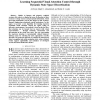55 search results - page 4 / 11 » Learning to navigate through crowded environments |
IAT
2005
IEEE
14 years 1 months ago
2005
IEEE
This paper presents a self-organizing cognitive architecture, known as TD-FALCON, that learns to function through its interaction with the environment. TD-FALCON learns the value ...
MC
2003
13 years 8 months ago
2003
Social navigation is the alternative way of looking upon navigation in the virtual world: e g instead of navigating the web by maps and hierarchies and search engines, you would n...
IDA
2003
Springer
14 years 20 days ago
2003
Springer
For a mobile robot to act autonomously, it must be able to construct a model of its interaction with the environment. Oates et al. developed an unsupervised learning method that pr...
ICMCS
2005
IEEE
14 years 1 months ago
2005
IEEE
: Personalized Education (PE) emphasizes the importance of individual differences in learning. To deliver personalized e-learning services and content, PE encompasses the abilities...
ICRA
2009
IEEE
14 years 2 months ago
2009
IEEE
² Similar to humans and primates, artificial creatures like robots are limited in terms of allocation of their resources to huge sensory and perceptual information. Serial process...

